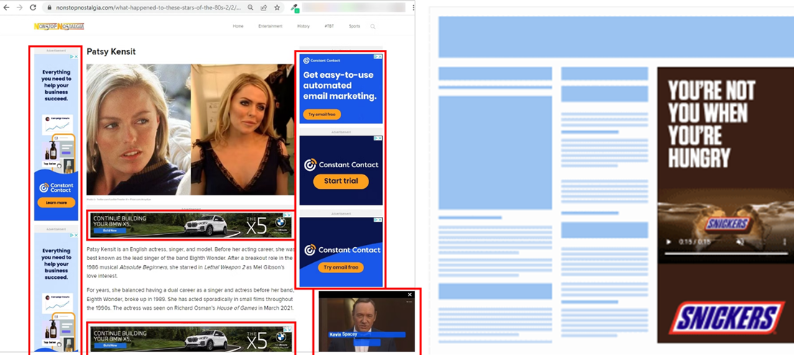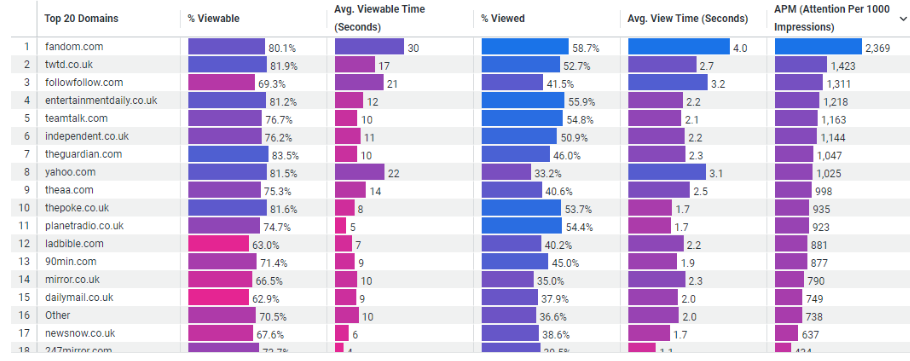3 Ways Advertisers Can Use Attention Metrics
to Avoid MFA Websites


Beyond the endless ‘death of the cookie’ chronicles, the other big topic in the advertising space this year has been made-for-advertising (MFA) websites. Recent research shows that low-quality websites are a big reason that 23% of programmatic ad spend now goes to waste. This amounts to more than $100 billion in wasted ad budget per year, according to the Association of National Advertisers
MFA websites are filled with numerous ads and minimal content that exploit ad campaigns that bid on viewability. Viewability, the standard metric for cost per impression (CPM), is determined by whether at least fifty percent of a display ad is visible for one second, or two seconds for video ads.

Lumen’s data shows that, on average, 70% of viewable ads aren’t seen at all – but advertisers get charged for all those impressions, anyway. Paying for ads based on viewability alone is like leaving the lights on when no one is home: it’s bad for the budget, bad for the environment and bad for outcomes!
Outcomes are far more likely to happen when your ad has been seen than when it hasn’t been seen – and the MFA crisis shows that where your ads get delivered really matters.
Here’s how advertisers can deliver ads on websites that get better results with attention-first advertising:
Your budget is almost spent. Most ads have been delivered. Do you know where they ended up?
With the fragmented ecosystem of ad-tech today, advertisers can spend as much time trying to measure every channel after a campaign as they do planning it. And by the time the results are in, the money is already spent.
By measuring campaigns based on attention metrics, not just viewability, advertisers gain access to a new dashboard that shows campaign performance – and domain performance – based on where your ads are actually being seen.
“By using Attention Metrics, advertisers can optimize their campaigns to target where their audience is actually viewing their ads. This approach not only enhances performance but also reduces ad spend on impressions that aren’t even seen,” says Bill Forelli, VP of Sales at Lumen.

“Recently, the Lumen team saved an international beverage brand $2 million in media spend just by eliminating poor-quality websites from the campaign,” Bill explains.
This all started with the Lumen Attention and Planning (LAMP) platform, which measures domains by both viewability and attention metrics – showing that many domains with high viewability don’t always have high attention.
Viewability is the go-to signal for media buyers, because “viewable” impressions are cheap and offer the promise of massive reach at a low cost. But these ads are generally low-attention ads – and Lumen has proven that low-attention ads lead to poorer performance across the funnel.
In last year’s third-party audit, PwC found that when brands buy based on Lumen’s Attention Metrics instead of viewability, campaigns see higher engagement and conversion. Last year, Lumen collaborated with an international coffee brand to develop a custom bidding algorithm focused on the impressions that garnered the most attention. This attention-first ad campaign resulted in an 8X increase in website conversions and significantly outperformed the reach-based campaign. As a result, the team revamped their entire media plan to prioritize attention signals.
Lumen enables Attention Bidding based on a custom algorithm that is generated from the largest eye-tracking Attention Dataset in world. The custom Attention Bidding algo is then integrated with Google DV360 or The Trade Desk.
By bidding based on Attention, instead of viewability, advertisers end up bidding on ad units that drive Attention with outcomes following.
Earlier this month, Lumen announced the launch of the most advanced inventory curation solution on the market, the Lumen Loop. The Lumen Loop combines Lumen Attention Measurement, expert analysis and targeting, and advanced activation to curate a high-performance Attentive private marketplace (aPMP). Through the delivery of a simple Deal ID, the Lumen Loop enables programmatic teams to target ad spend on inventory custom built to drive performance by eliminating poor-quality, low-attention websites.
As Bill says, “Lumen’s Attention experts, armed with 11+ years of Attention research experience, analyze programmatic Attention and performance data to identify the optimal levels of Attention to achieve specific brand outcomes. The outrageous performance is only matched by the simplicity of the activation: it’s a simple Deal ID that you can target to your heart’s content!”
The Lumen Loop has driven significantly higher effectiveness and efficiency: one major auto brand saw +441% higher conversions while lowering cost-per-action by 58%.
By curating better ad inventory where audiences were most likely to pay attention, the brand also saw +218% higher qualified conversions – so the ads performed better and reached more targeted audiences.
When you plan media based on attention, advertisers can optimize campaign performance based not only on how ads perform, but how domains perform.